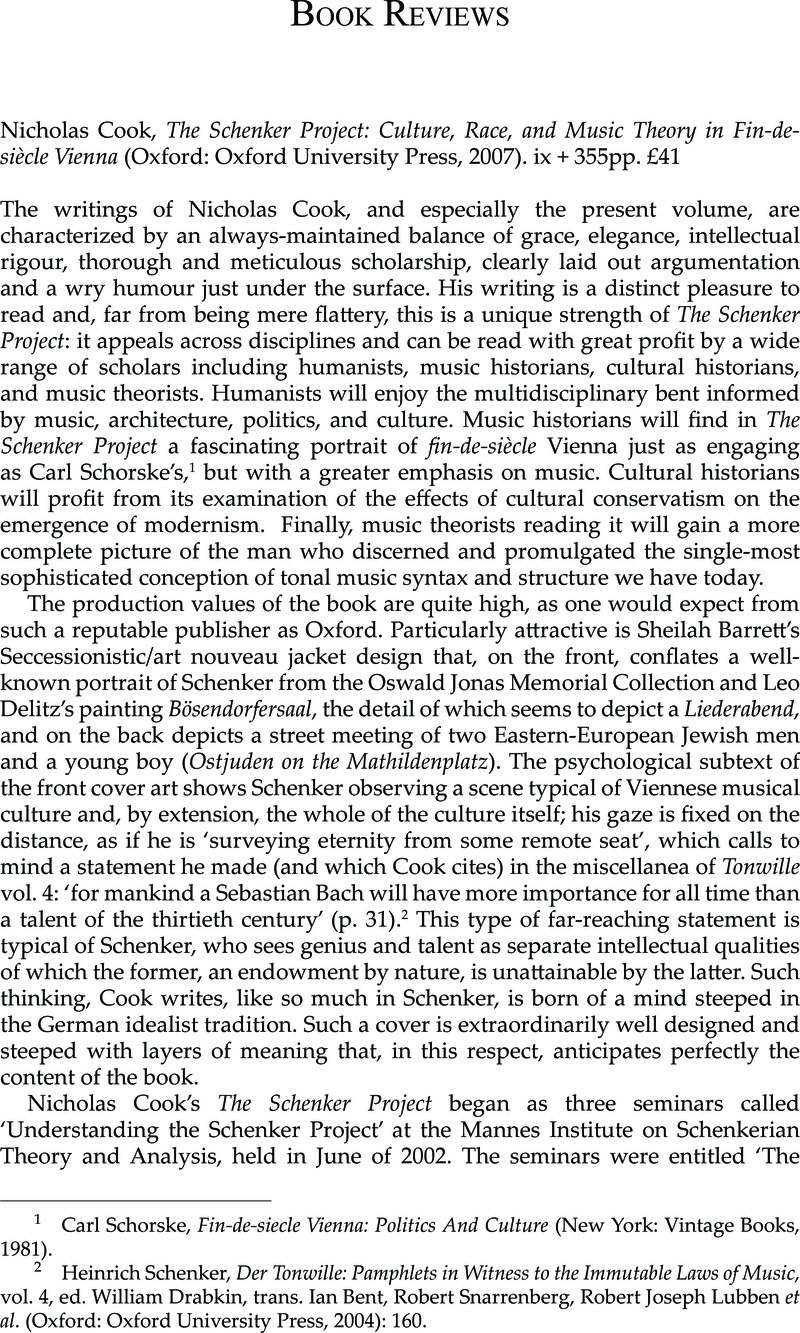No CrossRef data available.
Article contents
Nicholas Cook, The Schenker Project: Culture, Race, and Music Theory in Fin-de-siècle Vienna (Oxford: Oxford University Press, 2007). ix + 355pp. £41
Review products
Published online by Cambridge University Press: 13 April 2011
Abstract

- Type
- Book Reviews
- Information
- Copyright
- Copyright © Cambridge University Press 2009
References
1 Schorske, Carl, Fin-de-siecle Vienna: Politics And Culture (New York: Vintage Books, 1981).Google Scholar
2 Schenker, Heinrich, Der Tonwille: Pamphlets in Witness to the Immutable Laws of Music, vol. 4, ed. Drabkin, William, trans. Bent, Ian, Snarrenberg, Robert, Lubben, Robert Joseph et al. (Oxford: Oxford University Press, 2004): 160.Google Scholar
3 Schenker, Heinrich, The Masterwork in Music, vol. I, ed. Drabkin, William, trans. Ian Bent, Alfred Clayton, William Drabkin, Richard Kramer, John Rothgeb, Derrick Puffett and Hedi Siegel, Cambridge Studies in Music Theory and Analysis 5, 8 and 10 (Cambridge: Cambridge University Press, 1994): x.Google Scholar
4 Hepokoski, James, ‘The Dahlhaus Project and Its Extra-Musicological Sources’, 19th-Century Music 14 (1991): 221–46.CrossRefGoogle Scholar
5 Schenker's essay appeared first in Musikalisches Wochenblatt in 1895, based apparently on a lecture he gave at the University of Vienna. It has been translated as Schenker, Heinrich, ‘The Spirit of Musical Technique’, trans. Pastille, W., Theoria 3 (1988): 86–104;Google Scholar rev. ed. in Cook, N., The Schenker Project (New York: Oxford University Press, 2007): 319–32Google Scholar.
6 Schenker, Heinrich, The Art of Performance, ed. Esser, Herbert, trans. Scott, Irene Schreier (Oxford: Oxford University Press, 2000)Google Scholar; ‘A Contribution to the Study of Ornamentation’, trans. Siegel, Hedi, Music Forum 2 (1976): 1–139Google Scholar.
7 Riegl, Aloïs, Stilfragen, Grundlegungen zu eomer Geschichte der Ornamentik, trans. Kain, Evelyn (Princeton, NJ: Princeton University Press, 1992): xxii; andGoogle ScholarSchenker, Heinrich, Harmony, trans. Borgese, Elisabeth Mann (Chicago: University of Chicago Press, 1955): 12Google Scholar.
8 Schenker, , Der Tonwille, vol. 1: 3–21.Google Scholar
9 Schenker, Heinrich, Free Composition, 2 vols, ed. and trans. Oster, Ernst (New York: Longman, 1979), andGoogle ScholarCounterpoint, bks 1 and 2, ed. Rothgeb, John and Thym, Jürgen (New York: Schirmer, 1987)Google Scholar.
10 Miller, Patrick, ‘The Published Music of Heinrich Schenker: An Historical-Archival Introduction’, Journal of Musicological Research 10 (1990–1991): 177–97,Google Scholar cites Schenker's wish to originally call the work ‘Tanz oder Suite nach Jüdische Volksweisen’, later preferring ‘Syrische Tänze’, and Busoni's almost indignant reaction, ‘Why this concealment?!’
These are also cited in Beaumont, Anthony, ed., Ferruccio Busoni: Selected Letters (London and Boston, MA: Faber and Faber, 1987).Google Scholar
11 Schenker, Free Composition.
12 Schenker, Counterpoint.
13 Beller, Steven was a cultural historian and author of Vienna and the Jews, 1867–1938: A Cultural History (Cambridge: Cambridge University Press, 1989).Google Scholar
14 Borgese, Elizabeth, Harmony, ed. Jonas, Oswald (Chicago: University of Chicago Press, 1954),Google Scholar reprint ed., 1980. The ‘Last Five Beethoven Sonatas’ are cited as: Die letzten fünf Sonaten von Beethoven, Kritische Ausgabe mit Einführung und Erläuterung. Sonate E dur, op. 109 (Vienna: Universal Edition, 1913),Google Scholar rev. ed. edited by Oswald Jonas, 1971 as U.-E. 3976; Sonate As dur, op. 110 (Vienna: Universal Edition, 1914), rev. ed. edited by Oswald Jonas 1972 as U.-E. 3977Google Scholar; Sonate C moll, op. 111 (Vienna: Universal Edition, 1916),Google Scholar rev. ed. edited by Oswald Jonas 1971 as U.-E. 3978; Sonate A dur, op. 101 (Vienna: Universal Edition, 1920),Google Scholar rev. ed. edited by Oswald Jonas, 1972 as U.-E. 3974. The fifth remains unpublished because the manuscript is not extant.


